NCERT Solutions for Chapter 1 Number System Class 9 Maths
Book Solutions1
Answer
Yes, zero is a rational number. We can write it in the form (p/q).2
Answer
We know that there are an infinite number of rational numbers between two rational numbers. Therefore, six rational numbers between 3 and 4 can be:Let x = 3 and y = 4, also n = 6
Since, the six rational numbers between x and y are:
(x + d), (x + 2d), (x + 3d), (x + 4d), (x + 5d) and (x + 6d).
∴ The six rational numbers between 3 and 4 are:
3
Answer
Let x = (3/5), y = (4/5) and n = 5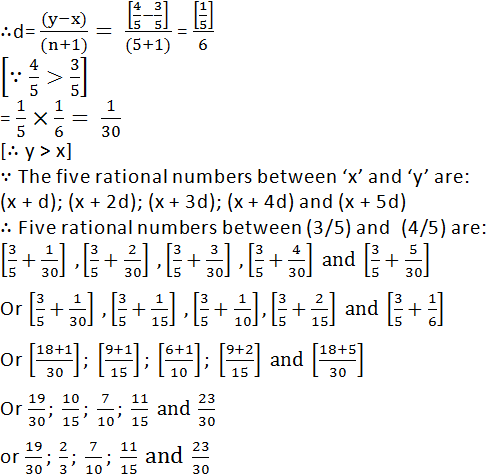
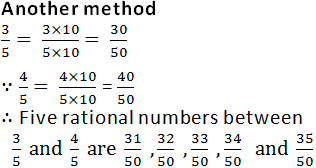
4(i)
Every natural number is a whole number.
Answer
True statement [∵ The collection of all natural numbers and 0 is called whole numbers]4(ii)
Every integer is a whole number.
Answer
False statement [∵ Integers such as –1, –2 are non-whole numbers]4(iii)
Every rational number is a whole number.
Answer
False statement [∵ Rational number (1/2) is not a whole number]1(i)
Every irrational number is a real number.
Answer
True statement, because all rational numbers and all irrational numbers form the group (collection) of real numbers.1(ii)
Every point on the number line is of the form √m, where m is a natural number.
Answer
False statement, because no negative number can be the square root of any natural number.1(iii)
Every real number is an irrational number.
Answer
False statement, because rational numbers are also a part of real numbers.2
Answer
No, if we take a positive integer, say 4 its square root is 2, which is a rational number.
Also, 4 is a rational number.
3
Answer
Let us take the horizontal line XOX" as the x-axis. Mark O as its origin such that it represents 0.
OA = 1 unit, AB = 1 unit.
∴ OB = 2 units
Draw a perpendicular, BC ⊥ OX.

Cut off BC = 1 unit.
Since OBC is a right triangle.
∴ OB2 + OC2 = OC2
or 22 + 12 = OC2 or 4 + 1 = OC2
or, OC2 = 5
⇒ OC = √5
With O as centre and OC as radius, draw an arc intersecting OX at D.
Since,
OC = OD
∴ OD represents √5 on XOX'.
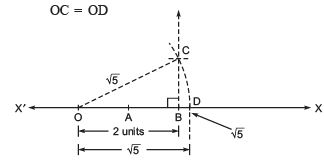
Remember
According to the Pythagoras theorem,
In a right-angled triangle, the square of the hypotenuse is equal to the sum of the squares of the other two sides.
In the figure: OB2 =OA2 + AB2
⇒ OB2 =12 + 12 = 2
⇒ OB = √2

4
Classroom activity (Constructing the ‘square root spiral’)

Answer
Take a large sheet of paper and construct the ‘square root spiral’ in the following fashion. Start with a point O and draw a line segment OP1 of unit length. Draw a line segment P1P2 perpendicular to OP1 of unit length (see Fig. 1.9). Now draw a line segment P2P3 perpendicular to OP2. Then draw a line segment P3P4 perpendicular to OP3. Continuing in this manner, you can get the line segment Pn–1Pn by drawing a line segment of unit length perpendicular to OPn–1. In this manner, you will have created the points P2 , P3 ,...., Pn ,... ., and joined them to create a beautiful spiral depicting √2, √3, √4, ...1(i)
36/100
Answer
We have 36/100 = 0.36∴ the decimal expansion of 36/100 is terminating.
1(ii)
1/11
Answer
Dividing 1 by 11, we have: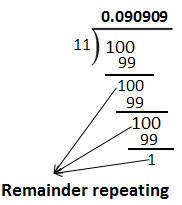
![]()
∴ Thus, the decimal expansion is “non-terminating repeating”.
Note: The bar above the digits indicates the block of digits that repeats. Here, the repeating block is 09.
1(iii)
Answer
To write ![]() in p/q from, we have
in p/q from, we have
![]()
Now, dividing 33 by 8, we have
![]()
Remainder = 0, means the process of division terminates.
![]()
∴ Thus, the decimal expansion is terminating.
1(iv)
3/13
Answer
Dividing 3 by 13, we have

3 came as a remainder. The dividend in first case was 3. So, the block of digits will repeat again.
Here, the repeating block of digits is 230769.
![]()
∴ Thus, the decimal expansion of 3/13 is “non-terminating repeating”.
1(v)
2/11
Answer
Dividing 2 by 11, we have

Here, the repeating block of digits is 18.
![]()
∴ Thus, the decimal expansion of 2/11 is “non-terminating repeating”.
1(vi)
329/400
Answer
Dividing 329 by 400, we have
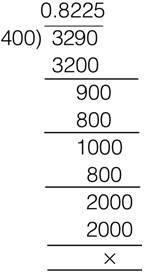
Remainder = 0, means the process of division terminates.
![]()
∴ Thus, the decimal expansion of 329/400 is terminating.
2
Answer
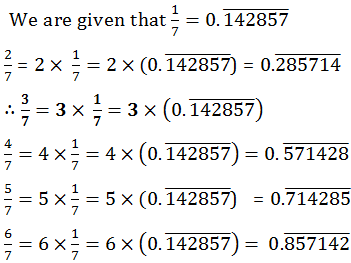
Thus, without actually doing the long division we can predict the decimal expansions of the above given rational numbers.
3
Answer
(i) Let x = ![]() = 0.6666… Since, there is one repeating digit.
= 0.6666… Since, there is one repeating digit.
∴ We multiply both sides by 10,
10x = (0.666…) x 10
or 10x = 6.6666…
∴ 10x - x = 6.6666... - 0.6666...
or 9x = 6
or x = 6/9 = 2/3![]()
(ii) Let X ![]() = 0.4777....
= 0.4777....
∴ 10x = 10× (0.4777 ... )
or 10x = 4.777 ...(1)
and 100x = 47.777 ...(2)
Subtracting (1) from (2), we have
100x – 10x = (47.777…) – (4.777…)
90x = 43
(iii) Let ![]() = 0.001001.... ...(1)
= 0.001001.... ...(1)
Here, we have three repeating digits after the decimal point, therefore we multiply by 1000.
∴ 1000x = 1000 ![]() = 1000×0.001001...
= 1000×0.001001...
or 1000x = 1.001001… ...(2)
Subtracting (1) from (2), we have
1000x – x = (1.001…) – (0.001…)
or 999x = 1
∴ x = 1/999![]()
4
Answer
Let x = 0.99999... ...(1)Multiply both sides by 10,
we have [∵ There is only one repeating digit.]
10 x x = 10 x (0.99999…)
or 10x = 9.9999 ...(2)
Subtracting (1) from (2),
we get 10x – x = (9.9999…) – (0.9999…)
or 9x = 9
or x = 9/9 = 1
Thus, 0.9999… = 1
As 0.9999… goes on forever, there is no gap between 1 and 0.9999
Hence both are equal.
5
Answer
Since, the number of entries in the repeating block of digits is less than the divisor.In 1/17, the divisor is 17.
∴ The maximum number of digits in the repeating block is 16. To perform the long division, we have
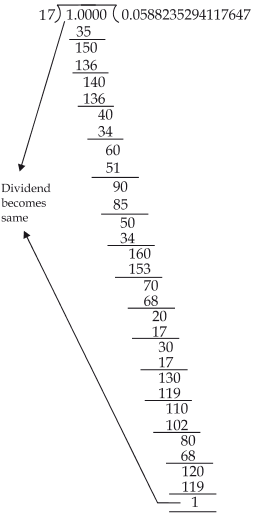
The remainder 1 is the same digit from which we started the division.
Thus, there are 16 digits in the repeating block in the decimal expansion of 1/17. Hence, our answer is verified.
6
Answer
Let us look at decimal expansion of the following terminating rational numbers:
We observe that the prime factorization of q (i.e. denominator) has only powers of 2 or powers of 5 or powers of both.
Note: If the denominator of a rational number (in its standard form) has prime factors either 2 or 5 or both, then and only then it can be represented as a terminating decimal.
7
Answer
√2=1.414213562…√3= 1.732050808…
√5=2.236067978 …
8
Answer
To express decimal expansion of 5/7 and 9/11, we have:

As there are an infinite number of irrational numbers between
(i) 0.750750075000750…
(ii) 0.767076700767000767…
(iii) 0.78080078008000780…
9
(i) √23
(ii)√225
(iii) 0.3796
(iv) 7.478478
(v) 1.101001000100001…
Answer
(i) ∵ 23 is not a perfect square.∴ is an irrational number.
(ii) ∵ √225 = 15 x 15 = 152
∴ 225 is a perfect square.
Thus, 225 is a rational number.
(iii) ∵ 0.3796 is a terminating decimal,
∴ It is a rational number.
(iv) 7.478478… =
∴ It is a rational number.
(v) Since, 1.101001000100001… is a non-terminating and non-repeating decimal number.
∴ It is an irrational number.
1
Answer
3.765 lies between 3 and 4.Let us divide the interval (3, 4) into 10 equal parts.
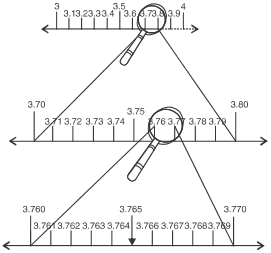
Since, 3.765 lies between 3.7 and 3.8. We again magnify the interval [3.7, 3.8] by dividing it further into 10 parts and concentrate the distance between 3.76 and 3.77.
The number 3.765 lies between 3.76 and 3.77. Therefore we further magnify the interval [3.76, 3.77] into 10 equal parts.
Now, the point corresponding to 3.765 is clearly located, as shown in Fig. (iii) above.
2
Answer
Note: We can magnify an interval endlessly using successive magnification.To visualize 4. or 4.2626… on the number line up to 4 decimal places, we use the following steps.
(i) . The number 4.2626… lies between 4 and 5. Divide the interval [4, 5] in 10 smaller parts:

(ii) . Obviously, the number 4.2626... lies between 4.2 and 4.3. We magnify the interval [4.2, 4.3]:

(iii) . Next, we magnify the interval [4.26, 4.27]:

(iv) . Finally magnify the interval [4.262, 4.263]:

In Fig. (iv), we can easily observe the number 4.2626… or
1
(i) 2-√5
(ii) (3 + √23 ) -√23
(iii) (2√7)/(7√7)
(iv) 1/√2
(v) 2π
Answer
i) 2 –√5
Since it is a difference of a rational and irrational number,
∴ 2 –√5 is an irrational number.
(ii) (3 + √23 ) - √23
We have (3 + √23 ) - √23 = 3 + √23 - √23 = 3 which is a rational number
∴ (3 + √23 ) - √23 is a rational number
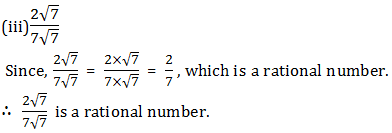
(iv) 1/√2
∵The quotient of rational and irrational is an irrational number.
∴ 1/√2 is an irrational number.
( v )2π
∵ 2π = 2 x π = Product of a rational and an irrational (which is an irrational number)
∴ 2π is an irrational number.
REMEMBER
For real numbers a, b, c and d, we have:
(i) √ab = √a . √b
(ii) √(a/b)= √a/√b
(iii) (√a+√b ) (√a- √b) = a- b
(iv) (a+√b) (a-√b) = a^2-b
(v) (√a+√b) (√c +√d) = √ac+√ad +√bc+ √bd
(vi) (√a+ √b)^2 = a+2√ab+b
2
(i) (3+ √3)(2+ √2)
(ii) (3+√3)(3-√3)
(iv) (√5+ √2)^2
(v) (√5- √2) (√5+√2)
Answer
(i) (3+ √3)(2+√2) - 2(3 +√3 ) + √2 (3 +√3)
= (2 x 3 + 2√3 ) + (3√2 +√2 x √3 )
= 6 + 2√3 + 3√2 + √6
Thus, (3 +√3 )(2 +√2 )
= 6 + 2√3 + 3√2 +√6
(ii) (3 +√3 )(3 – √3 )
= (3)2 – ( √3)2 [∵ (a + b)(a – b) = a2 – b2]
= 32 – 3
= 9 – 3 = 6
∴ (3 + √3 ) (3 – √3 ) = 6.
(iii) ( √5 +√2 )2
= (√5 )2 + (√2)2 + 2( √5)(√2)
[∵ (a + b)2 = a2 + b2 + 2ab]
= 5+2+2√10
= 7+2√10
∴(√5+√2)2 =7+ 2√10
(iv) ( √5 – √2 )( √5 + √2)
= (√5 )2 – (√2 )2 [∵ (a + b)(a – b) = a2 – b2]
= 5 – 2 = 3
∴ ( √5 – √2 )( √5 + √2) = 3
3
Answer
When we measure the length of a line with a scale or with any other device, we only get an approximate rational value, i.e. c and d both are irrational.
∴ c/d is irrational and hence π is irrational. Thus, there is no contradiction in saying that π is irrational.
4
Answer
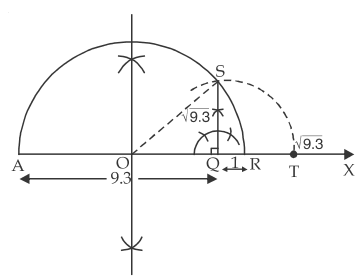
(i) Draw a ray AX.
(ii) Mark a point Q on the ray such that AQ = 9.3 units.
(iii) From Q, mark a point R such that QR =1 unit.
(iv) Draw perpendicular bisector of AR to obtain mid-point. Let us mark it as O.
(v) Taking O as centre and OR as radius draw a semicircle.
(vi) Draw QS ⊥ AX which cuts semicirle at S.
(vii) Taking Q as centre and QS as radius draw an arc cutting AX at T. Then QT = QS =√9.3
5
Rationalise the denominators of the following:
(i) 1/√7
(ii) 1/(√7-√6)
(iii) 1/(√5+√2)
(iv) 1/(√7-2)
Answer
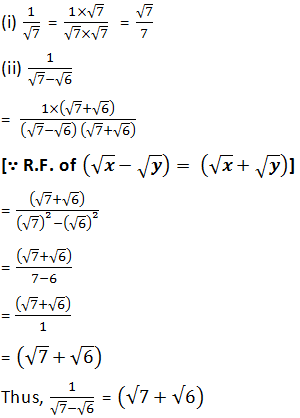

1
(i) 641/2
(ii) 321/5
(iii) 1251/3
Answer
(i) ∵ 64 = 8 x 8 = 82
∴ (64)1/2
= (82)1/2 = 82x1/2
[∵ (am)n = am x n]
= 81 = 8
Thus, 641/2 = 8
(ii) ∵ 32 = 2 x 2 x 2 x 2 x 2 = 25
∴ (32)1/5 = (25)1/5
= 25x1/5 [∵ (am)n = amn]
= 21 = 2
Thus, (32)1/5 = 2
(iii) ∵ 125 = 5 x 5 x 5 = 53
∴ (125)1/3 = (53)1/3
= 53x1/3 = 51
Thus, 1251/3 = 5
2
(i) 93/2
(ii) 322/5
(iii) 163/4
(iv) 125–1/3
Answer
(i) ∵ 9 = 3 x 3 = 32
∴ (9)3/2 = (32)3/2
= 32 x 3/2
= 33 = 27
Thus, 93/2 = 27
(ii) ∵ 32 = 2 x 2 x 2 x 2 x 2 = 25
∴ (32)2/5 = (25)2/5
= 25x2/5
= 22 = 4
Thus, 322/5 = 4
(iii) ∵ 16 = 2 x 2 x 2 x 2 = 24
∴ (16)3/4 = (24)3/4
= 24x3/4 = 23 = 8
Thus, 163/4 = 8
(iv) ∵ 125 = 5 x 5 x 5 = 53
∴ (125)–1/3 = (53)–1/3
= 53x(–1/3)
= 5–1 = 1/5
3
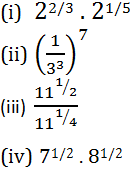
Answer
(i) ∵ am . an = am+n
∴ 22/3 . 21/5 = 22/3 + 1/5![]()
= 213/15
(ii) ∵ 1/am = a−m and (a−m)n
= a−mn = 1/amn
∴ (1/33 )7 = (3−3 )7
= 3−3×7= 3−21
= 1/321
Thus, (1/33 )7 = 1/321
(iii) 111⁄2/111⁄4
= 111⁄2 ÷ 111⁄4
= 111⁄2− 1⁄4 [∵ am/an = am−n]
= 111⁄4
Thus,
111⁄2/111⁄4 = 111⁄4
(iv) ∵ am . bm = (ab)m
∴ 71/2 . 81/2
= (7 x 8)1/2
= (56)1/2
Thus,
71/2 . 81/2 = (56)1/2